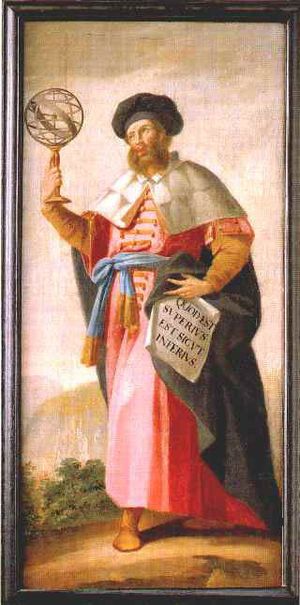Corpus Hermeticum

The Corpus Hermeticum, also called Poimandres after the title of the first text (Greek: Ποιμάνδρης "shepherd of men", from ποιμήν poimén "shepherd" and ἀνήρ anēr "man, human being"; Old Egyptian: Peime-nte-rê "Wisdom of Re"), is a collection of Greek treatises in epistolary, dialogue and sermon form on the origin of the world, the shape of the cosmos and human and divine wisdom. Hermes Trismegistus, to whom a multitude of religious, astrological and magical writings were attributed, was considered the author in ancient times.
Origin
The Corpus Hermeticum was written between 100 and 300 AD; the authors were probably Greeks who processed popular philosophical ideas of the time, "a mixture of Platonism and Stoicism, combined with Jewish and possibly some Persian elements".[1] It is disputed whether the interwoven elements of Egyptian mysteries indicate the involvement of Egyptian Neoplatonists, or whether it is pure fiction aimed at the enthusiasm for oriental cults typical of the time.
Other surviving Hermetica are the Asclepius, which was handed down together with the works of Apuleius of Madaura, as the latter was thought to be the translator of the lost Greek original (Coptic fragments of this were also found in the Nag Hammadi Library, Codex VI,8) and a very popular astrological aphorism collection entitled Centiloquium Hermetis, of which more than 80 manuscripts as well as several prints from the period between 1484 and 1533 have survived. In addition, there was the Tabula Smaragdina Hermetis, which had a great influence on alchemy, and the astral magical manual Picatrix; two Hellenistic writings that were handed down in the Islamic cultural sphere and translated from Arabic in the Middle Ages.
The spiritual background of the Hermetic tradition

According to Rudolf Steiner, the true spiritual origin of the Hermetic tradition actually lies in the Egyptian-Chaldean epoch.
„But the one in whom the Egyptians saw, so to speak, all the original greatness of that ancient clairvoyant wisdom, they called their great sage, the ancient Hermes. When, at a later time, a renewer of the ancient Egyptian wisdom came, he called himself Hermes again - as did so many, in fact, according to an old custom of the Egyptian sages. And his confessors, because they said that the wisdom of Hermes, who had lived in the distant past, had been revived, now called this first Hermes the Thrice Great: Hermes Trismegistus. But basically only the Greek called him Hermes; among the Egyptians he had the name Thoth.“ (Lit.:GA 60, p. 351)
In order to be able to fulfil his task, Hermes in his Egyptian incarnation carried within himself the completely purified astral body of Zarathustra, whose disciple he had been in an earlier incarnation. While Moses, the second important disciple of Zarathustra, had become acquainted with the mysteries of time, Hermes was initiated by Zarathustra into the mysteries of space. Hermes continued in the Egyptian period the confrontation with the ahrimanic powers that Zarathustra had begun in the ancient Persian period. People were to learn to appreciate the physical world as a sensually visible script of the gods, as a hieroglyph of the spirit, and as their new field of activity. According to ancient Egyptian tradition, therefore, the Egyptian hieroglyphic script goes back to Hermes. Ahriman was to be overcome in the earthly world by incorporating the light laws of the starry world into dark matter. This was the basis for both the monumental architecture of the Egyptians and alchemy. Chemi or Kemi was also the name that the ancient Egyptians themselves gave to their country.
Literature
- Frances A. Yates: Giordano Bruno and the Hermetic Tradition. London/New York 1964. Paperback London/Chicago 1991. ISBN 0-226-95007-7
- Julius Ruska: Tabula smaragdina: ein Beitrag zur Geschichte der hermetischen Literatur. Carl Winter's Universitätsbuchhandlung, Heidelberg 1926 PDF with handwritten annotations (German)
- Rudolf Steiner: Antworten der Geisteswissenschaft auf die großen Fragen des Daseins, GA 60 (1983), ISBN 3-7274-0600-3 English: rsarchive.org German: pdf pdf(2) html mobi epub archive.org
- Rudolf Steiner: Ägyptische Mythen und Mysterien, GA 106 (1992), ISBN 3-7274-1060-4 English: rsarchive.org German: pdf pdf(2) html mobi epub archive.org
References
- ↑ F. Yates (1991), p. 3.
| This article is partly based on the article Corpus Hermeticum from the free encyclopedia de.wikipedia and is licensed under Creative Commons Attribution/Share Alike. Wikipedia has a list of authors available. |
